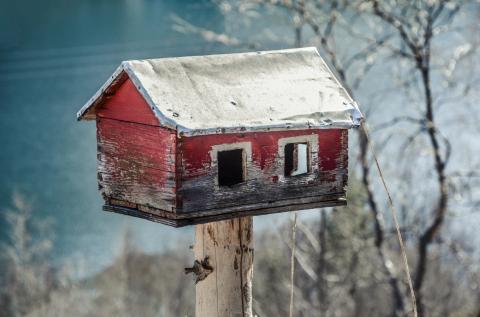February Gardening Tips

Tips for New Hampshire gardeners in February
Clean the leaves of foliage houseplants with a dusting cloth or by rinsing them in the sink. Built-up dust can reduce photosynthesis and plant growth.
Built-up dust on houseplant foliage can reduce photosynthesis and plant growth. Cleaning the leaves of plants not only makes them look better, but it will make them healthier. The easiest way to do this is to rinse plants in the kitchen sink or shower and gently spray them with lukewarm water. Avoid overly hot or cold water – these can damage foliage. Once plants have dried they can be moved back to their original location. Another option is to use a dusting cloth to clean individual leaves.
Inspect summer bulbs, like dahlias, cannas and gladiolus, in storage for signs of drying out or rotting.
Ideally summer bulbs should be kept chilled (below 50°F but above freezing) and stored in a material that maintains moisture around the tubers but allows air flow, such as moistened vermiculite, wood shavings, or sand. If bulbs seem to be drying out add a little moisture to packing material with a spray bottle. Additionally, remove any bulbs that have started to rot before the decay spreads to healthy bulbs. Bulbs can be planted in late spring once the soil has warmed and there is no longer a likely chance of frost.
When amaryllis have finished flowering, cut off the spent blooms to prevent plants from going to seed.
Make a point of only removing the spent flowers and leaving the flower stalk until it turns yellow or begins to wither. The flower stalk is capable of photosynthesis and will help create new energy that will recharge the bulb. Next, place the amaryllis in the sunniest possible spot in your home. A window with a southern exposure is the best choice. The long, strap-like leaves of amaryllis will photosynthesize and create energy that is stored in the bulb and used to create future flowers. An actively growing plant will require frequent watering and fertilization. Water when the soil at the top of the pot is dry, and apply a balanced liquid fertilizer every 2-4 weeks. Once the risk of frost has passed in the spring, move your amaryllis outside for the summer where it can receive more sunlight.
Protect Fruit Trees From Voles
Check fruit trees for evidence of rodent injury to bark. Voles damage trees by gnawing on their bark in the winter months, potentially girdling them. Damage will occur near the base of trees, just above and below the snow line. Nuisance voles can be trapped when the show is gone using mouse traps baited with peanut butter or fragrant apple slices. Cover traps with shingles or boards to create a sheltered spot that voles are likely to visit. Another option is to exclude voles from tree bark by placing hardware cloth (1/4 inch mesh) cylinders around trunks. Ideally tree guards should be put in place in the fall, but they can be added to trees in a pinch in the winter as needed.
Mark and Maintain Your Garden Tools
Mark handles of garden tools with bright paint or tape to keep them from getting lost in the garden. Spray paint or colored duct tape are durable options. Cleaning, sharpening and oiling tools are also excellent practices in the winter months.
Use Wood Ashes Judiciously
Don’t add wood ashes to the garden unless indicated by soil test. Wood ash raises the pH, or alkalinity, of the soil in a similar way to limestone. However, while limestone can take at least six months to change the soil pH, wood ash can change the pH rapidly. If the soil pH climbs above the optimum level plant growth can be affected adversely. The amount of wood ash required for your lawn and garden can be determined by soil testing. A typical 1,000 square foot garden with a pH of 6.5 would need no more than 20 pounds of wood ash (about enough to fill a five-gallon bucket) to maintain the pH at an optimal level. Keep in mind that some plants like azaleas, rhododendrons, blueberries, and potatoes grow best in acid soils, and generally should not be treated with wood ash.
Clean old nests out of bird houses.
Many species won’t use a birdhouse if it has a nest from a previous year inside, and rodents will often build nests in them during the winter months. February is a good time to clean any debris out of birdhouses, long before the songbird breeding season begins.
Do you love learning about stuff like this?
SUBSCRIBE TO GRANITE STATE GARDENING
A monthly newsletter for New Hampshire gardeners, homesteaders and plant-lovers of all kinds, that includes seasonal suggested gardening tips, upcoming events and articles with proven solutions for your garden and landscape.
Got questions? The Ask UNH Extension Infoline offers practical help finding answers for your home, yard, and garden questions. Call toll free at 1-877-398-4769, Monday to Friday, 9 a.m. to 2 p.m., or e-mail us at answers@unh.edu.
